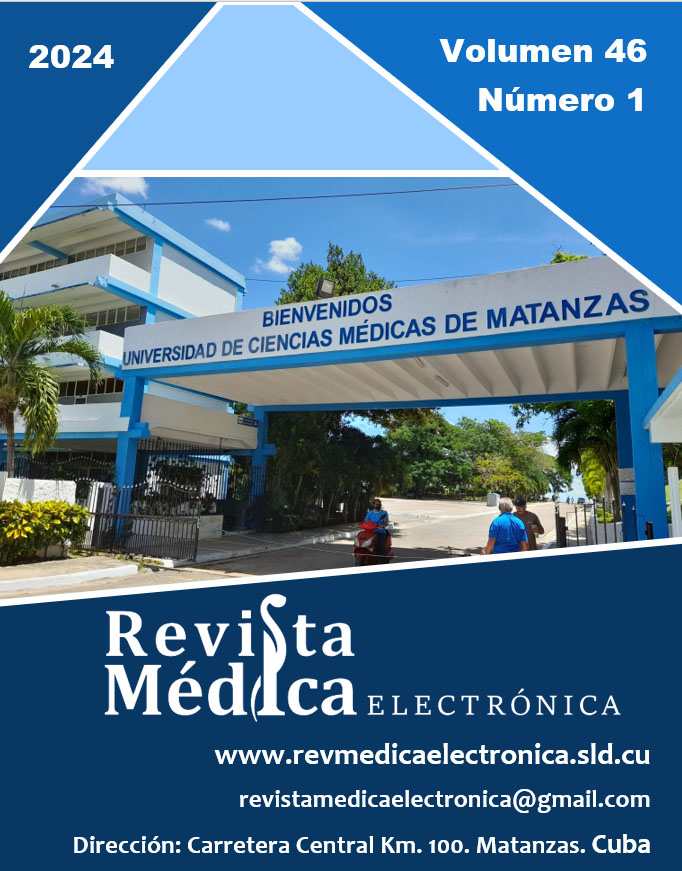Markov chains in the improvement of hospital patient flows: a bibliometric analysis
Keywords:
Markov chain, hospital management, patient flows, bibliometric analysis, processAbstract
Introduction: The management of patient flows influences hospital performance, and Markov chains are used to model them, helping to plan capacity, allocate resources and schedule admissions.
Objective: To evaluate the scientific activity related to the application of Markov chains in the improvement of patient flows in hospital institutions.
Methods: An observational, descriptive and retrospective bibliometric study was applied; the ScienceDirect database was used. The strategy was divided into three: evolution of the application of Markov chains in hospitals; specifically for management; and for the improvement of patient flows; 520, 331 and 9 documents were located, respectively.
Results: Research articles predominated, which accounted for 87.91 % of the scientific production. A total of 58.24 % of the articles were in the area of decision science. An analysis of the journals shows that 85.71 % were located in quartile 1, of which the one with the highest production was the European Journal of Operational Research. Four main lines of research were identified: resource optimization; capacity planning; policy development for activity sequencing; and modeling for improvement and decision making.
Conclusions: Future research should focus on collaborative analysis, country-specific productivity and generalization to other international impact databases.
Downloads
References
2. Jabalera M, Pons M, Gómez E, et al. Hacia la excelencia en gestión hospitalaria. Un modelo de gestión estratégica. J Health Qual Res. 2019;34(3):148-53. DOI: 10.1016/j.jhqr.2019.02.005.
3. Sánchez Suárez Y, Marqués León M, Hernández Nariño A, et al. Metodología para el diagnóstico de la gestión de trayectorias de pacientes en hospitales. Reg Cient. 2023;2(2):2023115. DOI: 10.58763/rc2023115.
4. Sánchez Suárez Y, Trujillo García L, Marqués León M, et al. Los indicadores de gestión hospitalarias en tiempos de Covid 19. Visionario Digital. 2021;5(4):58-77. DOI: 10.33262/visionariodigital.v5i4.1901.
5. Manchay Calvay A. Gestión moderna para una administración efectiva. Ñeque. 2022;5(11):143-51. DOI: 10.33996/revistaneque.v5i11.70.
6. Dawoodbhoy FM, Delaney J, Cecula P, et al. AI in patient flow: applications of artificial intelligence to improve patient flow in NHS acute mental health inpatient units. Heliyon. 2021;7(5):e06993. DOI: 10.1016/j.heliyon.2021.e06993.
7. Duarte Forero E, Camacho Oliveros MÁ. Planeación de la capacidad hospitalaria: un enfoque desde el flujo de pacientes con Dinámica de Sistemas. INGE CUC. 2020;16(1):217-33. DOI: 10.17981/ingecuc.16.1.2020.16.
8. Markazi Moghaddam N, Jame SZB, Tofighi E. Evaluating patient flow in the operating theater: An exploratory data analysis of length of stay components. Inform Med Unlocked. 2020;19:100354. DOI: 10.1016/j.imu.2020.100354.
9. Bhattacharjee P, Ray PK. Patient flow modelling and performance analysis of healthcare delivery processes in hospitals: A review and reflections. Comput Ind Eng. 2014;78:299-312. DOI: 10.1016/j.cie.2014.04.016.
10. Pantí-Trejo H, Batún Cutz J, Cool Padilla R, et al. Aspectos básicos en la Inferencia Estadística para Cadenas de Markov en tiempo discreto. Sahuarus. 2022;6(1):30-49: DOI: 10.36788/sah.v6i1.131.
11. Noda T, Lu X, Ishiguro Y, et al. Cost-effective analysis of automated programming optimization in cardiac resynchronization therapy: Holistic Markov modelling. J Cardiol. 2022;79(6):734-9. DOI: 10.1016/j.jjcc.2021.12.016.
12. Yesantharao PS, Lee E, Klifto K, et al. A Markov Analysis of Surgical vs Medical Management of Chronic Migraines. J Am Coll Surg. 2021;233(5):S195. DOI: 10.1016/j.jamcollsurg.2021.07.396.
13. Sarmentero Bon I, Sánchez Suárez Y, Rodríguez Sánchez Y, et al. Bibliometría sobre la cultura organizacional en el sector de la salud, ante la COVID-19. Universidad y Sociedad [Internet]. 2022 [accessed 2023/04/10];14(S6):427-36. Disponible en: https://rus.ucf.edu.cu/index.php/rus/article/download/3474/3418
14. Zetty Arenas C, Jácome Vallejo MA, Morales Quiceno ME, et al. La vigilancia científica como apoyo a la gestión educativa. Un análisis de la formación en Automatización Industrial. Rev Rutas form práct exp. 2020;(10):60-75. DOI: 10.24236/24631388.n.2020.3396.
15. Rismanchian F, Kassani SH, Shavarani SM, et al. A Data-Driven Approach to Support the Understanding and Improvement of Patients’ Journeys: A Case Study Using Electronic Health Records of an Emergency Department. Value Health. 2023;26(1):18-27. DOI: 10.1016/j.jval.2022.04.002.
16. Shakeri M, Haji B, Farrokhvar L. A partially flexible routing strategy for assigning emergency department patients to inpatient wards. Comput Ind Eng. 2023;176:108810. DOI: 10.1016/j.cie.2022.108810.
17. Andersen AR, Nielsen BF, Reinhardt LB, et al. Staff optimization for time-dependent acute patient flow. Eur J Oper Res. 2019;272(1):94-105. DOI: 10.1016/j.ejor.2018.06.015.
18. Andersen AR, Vancroonenburg W, Vanden Berghe G. Strategic room type allocation for nursing wards through Markov chain modeling. Artif Intell Med. 2019;99:101705. DOI: 10.1016/j.artmed.2019.101705.
19. Kato-Lin YC, Padman R. RFID technology-enabled Markov reward process for sequencing care coordination in ambulatory care: A case study. Int J Inf Manage. 2019;48:12-21. DOI: 10.1016/j.ijinfomgt.2019.01.018.
20. Gu W, Fan N, Liao H. Fitting aggregated phase-type distributions to the length-of-stay in intra-hospital patient transfers. Oper Res Health Care. 2021;29:100291. DOI: 10.1016/j.orhc.2021.100291.
21. Zehrouni A, Augusto V, Garaix T, et al. Hospital flood emergency management planning using Markov models and discrete-event simulation. Oper Res Health Care. 2021;30:100310. DOI: 10.1016/j.orhc.2021.100310.
22. Georgiou AC, Thanassoulis E, Papadopoulou A. Using data envelopment analysis in markovian decision making. Eur J Oper Res. 2022;298(1):276-92. DOI: 10.1016/j.ejor.2021.06.050.
23. Sánchez Suárez Y, Marqués León M, Hernández Nariño A, et al. Modelación de los flujos de pacientes de alto riesgo con COVID-19 en Matanzas con enfoque Lean. Rev Méd Electrón [Internet]. 2023 [accessed 2023/04/10];45(4):629-43. Available from: http://scielo.sld.cu/pdf/rme/v45n4/1684-1824-rme-45-04-629.pdf
Published
How to Cite
Issue
Section
License
All content published in this journal is Open Access, distributed under the terms of the CC BY-NC 4.0 License.
It allows:
- Copy and redistribute published material in any medium or format.
- Adapt the content.
This will be done under the following terms:
- Attribute the authors' credits and indicate whether changes were made, in which case it must be in a reasonable way.
- Non-commercial use.
- Recognize the journal where it is published.
The copyrights of each article are maintained, without restrictions.






